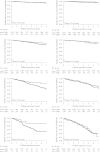Trends in stroke incidence rates and stroke risk factors in Rotterdam, the Netherlands from 1990 to 2008
- PMID: 22426770
- PMCID: PMC3370158
- DOI: 10.1007/s10654-012-9673-y
Trends in stroke incidence rates and stroke risk factors in Rotterdam, the Netherlands from 1990 to 2008
Abstract
Stroke incidence rates have decreased in developed countries over the past 40 years, but trends vary across populations. We investigated whether age-and-sex-specific stroke incidence rates and associated risk factors as well as preventive medication use have changed in Rotterdam in the Netherlands during the last two decades. The study was part of the Rotterdam Study, a large population-based cohort study among elderly people. Participants were 10,994 men and women aged 55-94 years who were stroke-free at baseline. Trends were calculated by comparing the 1990 subcohort (n=7516; baseline 1990-1993) with the 2000 subcohort (n=2883; baseline 2000-2001). Poisson regression was used to calculate incidence rates and incidence rate ratios in age-and-sex-specific strata. We further compared the prevalence of stroke risk factors and preventive medication use in the two subcohorts. In the 1990 subcohort 467 strokes occurred during 45,428 person years; in the 2000 subcohort 115 strokes occurred in 18,356 person years. Comparing the subcohorts, incidence rates decreased by 34% in men, but remained unchanged in women. Blood pressure levels increased between 1990 and 2000, whereas the proportion of current cigarette smokers decreased in men, but not in women. There was a strong increase in medication use for treatment of stroke risk factors across all age categories in both sexes. Our findings suggest that in Rotterdam between 1990 and 2008 stroke incidence rates have decreased in men but not in women.
Figures
References
Publication types
MeSH terms
Substances
LinkOut - more resources
Full Text Sources
Medical
Miscellaneous


